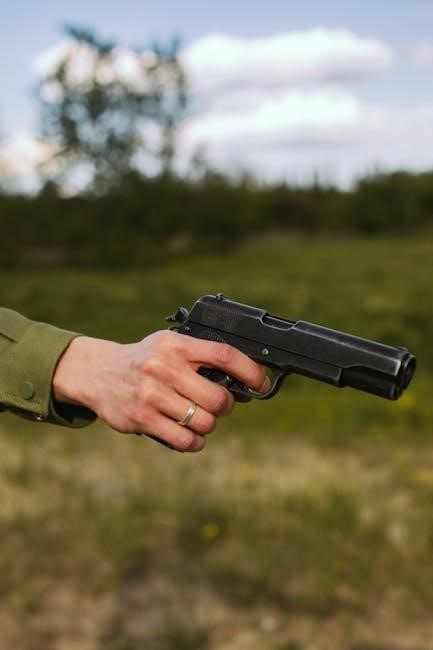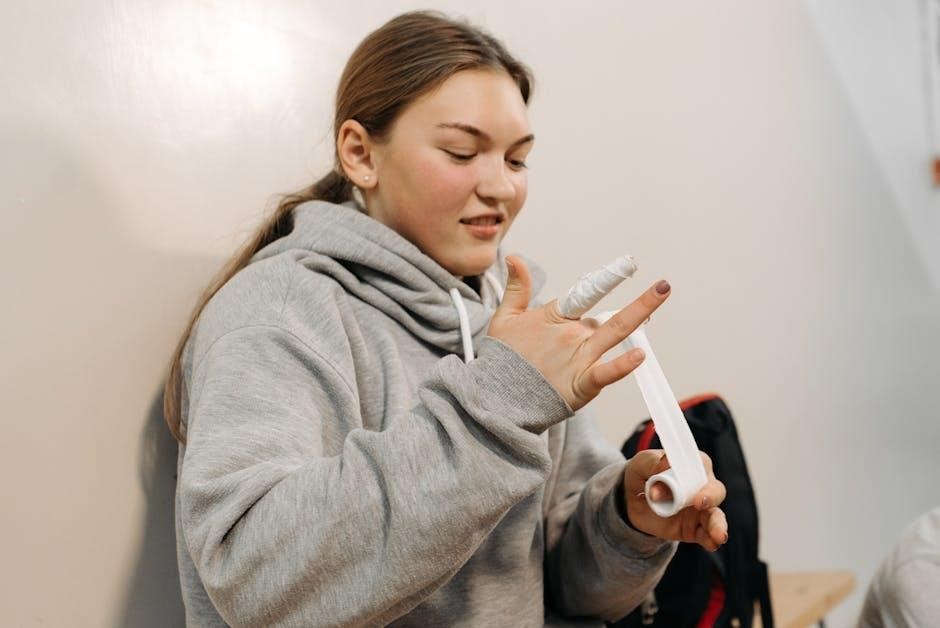Trigger Finger Exercises: A Comprehensive Guide
Welcome to a detailed exploration of trigger finger exercises!
This guide is designed to provide you with a clear understanding
of exercises and therapies․
We aim to equip you with knowledge to manage symptoms, improve
flexibility, and promote healing in your fingers and hand․
Understanding Trigger Finger
Trigger finger, also known as stenosing tenosynovitis, is a condition affecting the tendons in your fingers or thumb․ It leads to pain, stiffness, and a sensation of locking or catching when you bend or straighten the affected digit․ Understanding the mechanics behind this condition is crucial for effective management․ Tendons are connective tissues that attach muscles to bones, enabling movement․ In trigger finger, the tendon’s smooth gliding motion within its sheath is impaired due to inflammation or thickening․
This thickening creates a nodule on the tendon, making it difficult to pass through the sheath․ As a result, the finger may get stuck in a bent position and then snap straight with a trigger-like sensation․ The ring finger and thumb are the most commonly affected, but it can occur in any finger․ Recognizing the underlying cause allows for targeted exercises and therapies to alleviate symptoms and restore normal finger function․
Symptoms and Causes of Trigger Finger
The symptoms of trigger finger can vary in severity, often starting with mild discomfort and progressing to more pronounced issues․ Common symptoms include stiffness in the finger, especially in the morning, a tender lump in the palm at the base of the affected finger, a popping or clicking sensation when you move the finger, and the finger locking or catching in a bent position․ In severe cases, the finger may become permanently stuck in a bent position․
The exact causes of trigger finger are not always clear, but several factors can contribute to its development․ These include repetitive hand motions, forceful gripping, and prolonged use of vibrating tools․ Certain medical conditions, such as rheumatoid arthritis and diabetes, can also increase the risk of developing trigger finger․ Additionally, trauma or injury to the palm or base of the finger can sometimes lead to this condition․
The Importance of Exercise for Trigger Finger
Exercise plays a crucial role in managing and alleviating the symptoms of trigger finger․ While trigger finger is not caused by a lack of strength, targeted exercises can significantly improve flexibility and range of motion in the affected finger․ Regular exercise helps to keep the finger joints mobile, reducing stiffness and preventing the finger from locking up․
Flexibility exercises, such as tendon glides, help to mobilize the tendons along the fingers, decreasing tension and improving movement․ Blocking exercises, which isolate specific finger joints, can restore strength and prevent further problems․ Wrist exercises, including flexion, extension, and circumduction, also contribute to overall hand health and can ease trigger finger symptoms․ Consistent exercise can promote healing, reduce pain, and improve the functionality of the hand․

Effective Trigger Finger Exercises
Explore effective trigger finger exercises designed to improve
flexibility and reduce stiffness․ These exercises, including
tendon glides and joint-blocking techniques, are crucial for
managing symptoms and restoring hand function․ Regular practice
can promote healing and ease pain․
Tendon Glides
Tendon glides are a series of hand exercises designed to improve the mobility of the tendons in your fingers and reduce tension․ These exercises help the tendons move more smoothly through their sheaths, decreasing the likelihood of catching or locking․ Tendon glides are crucial in managing trigger finger symptoms by promoting flexibility and reducing stiffness․
To perform tendon glides, start with your hand straight and fingers extended․ Then, make a hook fist, followed by a straight fist (fingers bent at the large knuckles), and finally, make a full fist․ Return to the starting position after each step․ Repeat this sequence several times a day to maintain and improve tendon flexibility․
Regular practice of tendon glide exercises can significantly improve your hand function and reduce the pain associated with trigger finger․ Consistent movement helps prevent the tendons from adhering to the surrounding tissues, thus promoting smoother, pain-free motion․ Remember to perform these exercises gently and stop if you experience increased pain․
Distal Interphalangeal (DIP) Joint Blocking Exercise
The Distal Interphalangeal (DIP) joint blocking exercise focuses on isolating and strengthening the joint closest to your fingertip․ This exercise helps restore strength, prevent further problems, and relieve pain and stiffness in the affected finger․ By specifically targeting this joint, you can improve its range of motion and reduce the symptoms of trigger finger․
To perform the DIP joint blocking exercise, gently hold the middle joint of the affected finger to stabilize it․ Then, try to bend only the DIP joint (the joint closest to your fingertip) as far as comfortably possible․ Hold this position for a few seconds, and then straighten the joint․ Repeat this exercise several times a day, focusing on controlled, gentle movements;
Consistent practice of the DIP joint blocking exercise can significantly enhance the flexibility and strength of your fingertip joint․ This targeted approach helps prevent the joint from locking and reduces discomfort associated with trigger finger․ Remember to perform the exercise slowly and stop if you experience any sharp pain․
Proximal Interphalangeal (PIP) Joint Blocking Exercise
The Proximal Interphalangeal (PIP) joint blocking exercise targets the middle joint of your finger, nearest to your palm․ This joint is crucial for bending and extending your finger and can become stiff due to trigger finger․ This exercise helps restore mobility and reduce stiffness by isolating the PIP joint․
To perform this exercise, hold the base of your finger (near your palm) and the fingertip to stabilize them․ Focus on bending only the PIP joint (the middle joint) as far as you comfortably can․ Hold this flexed position for a few seconds, then straighten the joint․ Repeat this process multiple times throughout the day․
Consistency is key to improving the range of motion in your PIP joint and alleviating trigger finger symptoms․ Gentle, controlled movements are essential to avoid overstraining the joint․ If you experience any sharp pain, discontinue the exercise and consult with a healthcare professional․ Regular practice of the PIP joint blocking exercise can significantly enhance finger flexibility and reduce discomfort․
Wrist Flexion and Extension Exercises
Wrist flexion and extension exercises are vital for maintaining overall hand and wrist health, which indirectly supports finger function and can alleviate trigger finger symptoms․ Wrist flexion involves bending your hand downwards at the wrist, so your palm faces your arm․ Extension, conversely, involves moving your hand backward so your palm faces upwards․

To perform wrist flexion, extend your arm straight out in front of you, palm down․ Gently bend your wrist downwards, pointing your fingers towards the floor․ Hold this position for a few seconds, then return to the starting position․ For wrist extension, start with your arm extended, palm down․ Gently bend your wrist upwards, pointing your fingers towards the ceiling․ Hold and return․
These exercises enhance wrist mobility, which is often compromised by repetitive hand movements or conditions like trigger finger․ Perform two sets of 15 repetitions of each exercise, two to three times daily, to maintain wrist flexibility and promote healthy tendon gliding․ Remember to perform these exercises slowly and with control, avoiding any sudden or jerky movements that could exacerbate pain․
Wrist Circumduction
Wrist circumduction, a circular motion exercise for the wrist, can significantly improve flexibility and reduce stiffness, indirectly easing trigger finger symptoms․ This exercise promotes fluid movement within the wrist joint, enhancing overall hand function and contributing to better tendon gliding, which is crucial for managing trigger finger․
To perform wrist circumduction, begin by extending your arm straight out in front of you, keeping your wrist relaxed․ Gently rotate your wrist in a circular motion, moving it clockwise for a set number of repetitions․ After completing the clockwise rotations, switch direction and rotate your wrist counter-clockwise for the same number of repetitions․ Imagine you are tracing circles in the air with your hand․
Aim for two sets of 15 repetitions in each direction, performing this exercise two to three times daily․ Consistent practice of wrist circumduction can help maintain wrist mobility, reduce stiffness, and improve the overall health of your hand․ This exercise is especially beneficial for individuals experiencing limited range of motion due to trigger finger․
Palm Strength Exercises
Palm strength exercises are crucial for maintaining and improving hand function, indirectly benefiting individuals with trigger finger․ While trigger finger primarily affects tendons, strengthening the muscles in the palm can provide additional support and stability to the hand, promoting better overall movement and reducing strain on the affected tendons․ These exercises enhance grip strength and dexterity․
One effective palm strength exercise involves gently pushing the thumb and fingers outwards, as if you’re trying to open your palm against resistance․ You can use a rubber band placed around your fingers to provide extra resistance, enhancing the strengthening effect․ Repeat this exercise 10 times, performing it around five times per day․
Another variation involves placing your palm flat on a table with your finger pads touching the surface․ Gently push down with your fingers, extending them closer to the table․ Repeat this exercise on any stiff fingers to improve mobilization․ Consistent performance of palm strength exercises can contribute to increased hand strength, improved flexibility, and reduced discomfort associated with trigger finger․
Ball Squeeze Exercise
The ball squeeze exercise is a simple yet effective method to enhance hand strength and improve the flexibility of fingers affected by trigger finger․ This exercise involves using a soft ball or stress ball, which provides gentle resistance to strengthen the muscles in the hand and forearm․ Consistent practice can help alleviate stiffness and improve overall hand function․
To perform the ball squeeze exercise, hold a soft ball in your affected hand․ Gently squeeze the ball, maintaining the squeeze for a few seconds before releasing․ Repeat this action 10-15 times․ This exercise not only strengthens the hand muscles but also promotes better circulation, reducing inflammation and improving the range of motion in the fingers․
The ball squeeze exercise can be easily incorporated into your daily routine․ Regular performance of this exercise can lead to improved hand strength, reduced pain, and enhanced flexibility, making it an invaluable tool in managing trigger finger symptoms․ Remember to perform the exercise gently and gradually increase the intensity to avoid overexertion․

Additional Therapies and Considerations
Beyond exercise, managing trigger finger involves varied approaches․
Rest, splinting, heat, and massage offer relief․
Adaptive tools, medication, and injections might be helpful․
Surgery is a last resort;
Consult a healthcare provider for a personalized plan․

Rest and Splinting
One of the initial and easiest ways to manage symptoms of trigger finger is through adequate rest․ Resting the affected hand and finger is crucial, allowing the inflamed tendons time to heal and reducing further irritation․ It is important to give your finger time to heal, which could take several weeks, so that you can bend the finger again;
Any overexertion can damage the finger joint, which could lead to joint, tendon, or nerve damage․
Splinting plays a significant role by immobilizing the affected finger, typically in a straight position, to minimize strain during daily activities and provide a period for recovery․ It is essential to use a splint over the affected finger to hold it in place in a straight position․ Splinting helps to reduce strain, twisting, or bending of your affected finger․ Movement can lead to tissue damage and prolong your recovery time․ Trigger finger also causes the affected finger to be incredibly stiff in the morning, so splint therapy can help reduce morning stiffness․
Heat Therapy and Massage
Heat therapy is a valuable tool in managing trigger finger symptoms, utilizing methods like moist heating pads or soaking the affected finger in warm water to alleviate stiffness and pain․ Heat can also increase blood flow․ Soaking the affected finger in warm water, especially when symptoms first start, can ease them․ The warmth will dilate blood vessels and improve blood flow to reduce inflammation and stiffness․
Massage can be another effective approach to unlock a trigger finger․ To massage the affected finger, apply gentle pressure and a circular motion at the affected knuckle and the base of the finger on the palm side․ It is also important to massage the fingers, hand, wrist, and forearm connected to the affected finger․ You can follow the massage with hand and finger stretches․
